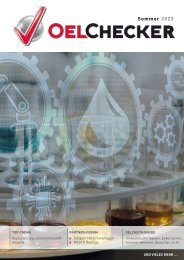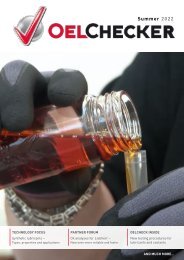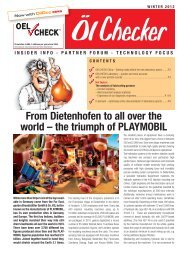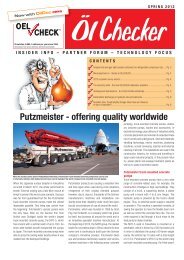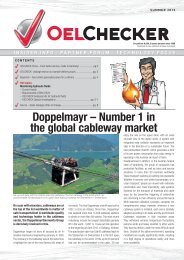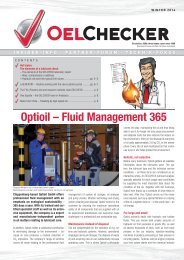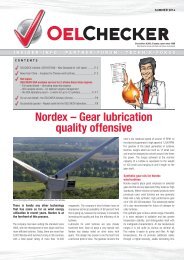OELCHECKER - Spring 2013
> Editorial – OELCHECK takes decisive steps for the years to come > OELCHECK – A strong brand with a new look > New services offered by the OELCHECK laboratory > Lubricants and condition monitoring – OELCHECK recognises trends > Gas engine oils – Latest information on oxidation determination > China – Opening of the OELCHECK laboratory in Guangzhou > Q & A – How can there be high levels of wear metals with normal purity classes? > OilDoc news
> Editorial – OELCHECK takes decisive steps for the years to come
> OELCHECK – A strong brand with a new look
> New services offered by the OELCHECK laboratory
> Lubricants and condition monitoring – OELCHECK recognises trends
> Gas engine oils – Latest information on oxidation determination
> China – Opening of the OELCHECK laboratory in Guangzhou
> Q & A – How can there be high levels of wear metals with normal purity classes?
> OilDoc news
- No tags were found...
Create successful ePaper yourself
Turn your PDF publications into a flip-book with our unique Google optimized e-Paper software.
OELCHECK TECHNOLOGY FOCUS<br />
Oxidation of gas engine oils<br />
Why does infrared spectroscopy sometimes come up short?<br />
In assessing how much longer a gas engine oil can be used or whether an oil change is necessary, oil ageing or oil oxidation is a<br />
crucial factor. Long periods of oil use, relatively high operating temperatures or rising contamination levels aggravate oil oxidation<br />
and the associated formation of acidic reaction products. Oils in gas engines fuelled with biogas, landfill gas, sewage gas or wood<br />
gas are often exposed to acidic gas components. Since the composition of these gases often varies, changing the oil at fixed intervals<br />
can be risky, in contrast to the situation with relatively clean natural gas. Oils in biogas engines must therefore be monitored<br />
constantly using lubricant analysis according to manufacturer specifications.<br />
[%]<br />
smission [<br />
Trans<br />
19 A/cm<br />
1<br />
<br />
F<br />
Differ<br />
smission [%]<br />
Tran<br />
1 A/cm<br />
Used oil<br />
Fresh oil<br />
Differential spectrum<br />
1960<br />
1760<br />
1560<br />
1360 1160 960<br />
[cm 1 ]<br />
760<br />
560<br />
1960<br />
1760<br />
1560<br />
1360 1160 960<br />
We [cm -1 ]<br />
760<br />
560<br />
Valid oxidation determination according to DIN 51453 (left) and similar oxidation determination spoiled by ester components (right).<br />
A DIN standard<br />
that is no longer effective<br />
For a long time infrared spectroscopy was the<br />
only method for measuring oil oxidation. With the<br />
mineral oils predominantly used around 20 years<br />
ago, the spectrum indicated the oxidation so clearly<br />
that values determined using the IR method according<br />
to DIN 51453 were specified by gas engine<br />
manufacturers. This was based on the fact that<br />
ageing is accompanied by the accumulation of<br />
oxygen on the molecular chains of the hydrocarbon<br />
oils and the formation of new molecular chains.<br />
When they are illuminated with infrared light, they<br />
absorb it differently than fresh oil. A clear peak is<br />
visible in the IR spectrum of an oxidised mineral oil<br />
at a wave number of about 1,710 cm -1 . After the<br />
fresh oil spectrum is subtracted from the used oil<br />
spectrum in this region, the oxidation is stated as<br />
the IR absorption referenced to a one-centimetre oil<br />
layer thickness (A/cm).<br />
However, this logical procedure does not work with<br />
some modern gas engine oils. In region of wave<br />
number 1,710 cm -1 , the IR spectrum also indicates<br />
the double bonds typical of synthetic oils containing<br />
esters or some oil additives. Oxidation products<br />
and esters cause peaks in the same region,<br />
with a distinct overlapping of the ester peaks and<br />
the oxidation peak.<br />
For gas engine oils based on petroleum, IR spectroscopy<br />
still provides reliable information on oil<br />
ageing and the limits specified by the DIN standard<br />
are still valid. But since many modern gas engine<br />
oils contain synthetic group I or group II base oils<br />
and most of them also contain low-ash additives, IR<br />
spectroscopy in accordance with the DIN standard<br />
cannot provide any useful oil oxidation values for<br />
these oils. Base oils and additives may contain thermally<br />
stable ester-based synthetic oils that distinctly<br />
overlap the oxidation peak at the specified wave<br />
number of 1,710 cm -1 . If such a peak is already<br />
present in the fresh oil, subtraction often does not<br />
provide a meaningful oxidation value. Even heavily<br />
oxidised oils will yield a value of 1 A/cm. The value<br />
at 1,710 cm -1 often lies on a shoulder of the peak,<br />
giving rise to what appears to be strongly varying<br />
oxidation values. For example, a value of 1 A/ cm,<br />
18 A/ cm or even 27 A/ cm might be calculated for<br />
oils with the same degree of oxidation using the<br />
standard-compliant method.<br />
High time for a new, uniform rule<br />
Engine manufacturers and insurance companies<br />
are still specifying that the oxidation value has to be<br />
determined using IR spectroscopy in accordance<br />
with DIN 51453, and most of them set a limit of<br />
20 A/cm. This is counter-productive for assessing<br />
some modern oils. It is high time to define a<br />
standard test method for determining oxidation that<br />
is also valid for modern gas engine oils. It should be<br />
defined such that it can be implemented worldwide<br />
in any laboratory for used oil analysis.<br />
Until then, we at OELCHECK wish to assure our<br />
customers that when assessing the ageing of<br />
modern engine oils we do not rely solely on oxidation<br />
as determined in accordance with DIN 51453,<br />
which is not usable in this situation. Instead, we<br />
presently use trend analysis of a combination of<br />
several analysis values as a reliable way to evaluate<br />
ageing. Along with the engine type, the gas type<br />
and the engine oil used, the findings from IR spectroscopy<br />
are augmented by viscosity, AN, BN, and<br />
ipH data. In making this assessment, OELCHECK<br />
diagnostic engineers benefit from their extensive<br />
experience and our comprehensive database. Our<br />
customers can therefore rely on accurate oil ageing<br />
information in the laboratory reports. However,<br />
a standardised redefinition of the test method is<br />
urgently needed.<br />
P.S.: The situation with modern gas engine oils<br />
is not the only one where determining oxidation<br />
by subtracting peaks at a specific wave number<br />
causes problems. New synthetic gear oils, such as<br />
those used in wind turbine gear units, present a<br />
similar problem in oxidation determination because<br />
many of them also contain synthetic base oils or<br />
ester-based additives.<br />
5




